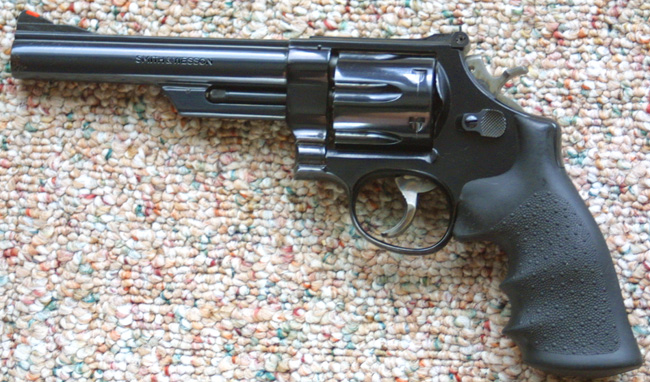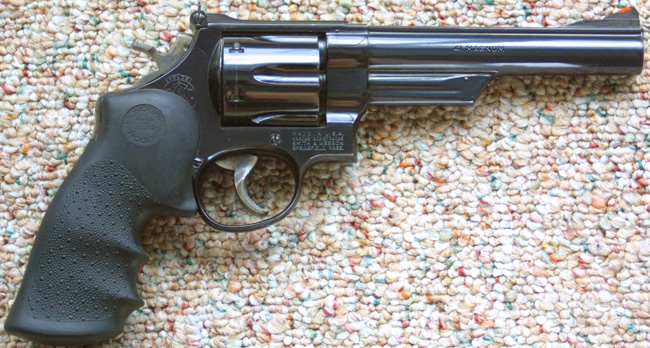 S&W Model 57
S&W Model 57
| Length Overall | Barrel Length | Weight | Caliber | Action Type | Magazine capacity |
| 11 1/2" | 6" | 48oz | .41 Magnum | DA Revolver | 6 |
 magnum tripod. The other two pistols were the M-29 (discontinued, but now
embodied in the 629), and the M-27(discontinued). There were, and are, other
N frame pistols, but these were the top of the line revolvers, and the guns
in this series were all given the finest fit and finish that S&W could
provide. The guns were designed as target pistols, and all came with target
triggers, hammers, and sights. The cartridges fired by these massive guns,
were the only magnum pistol cartridges being churned out, at the time of
their introduction, and remained so, for many years; each was the most powerful
round of it's size. These were, for decades, the finest revolvers being produced,
by the world's premier revolver manufacturer. These were the guns which made
Smith and Wesson's reputation, even as the popular K frame revolvers made
their fortune. The only competition for these guns, came from the Colt Python.
It is a matter of conjecture whether the smaller framed Colt was the better
gun, in .357, or not, but there was never any competitor in the larger .41,
and .44 magnums.
magnum tripod. The other two pistols were the M-29 (discontinued, but now
embodied in the 629), and the M-27(discontinued). There were, and are, other
N frame pistols, but these were the top of the line revolvers, and the guns
in this series were all given the finest fit and finish that S&W could
provide. The guns were designed as target pistols, and all came with target
triggers, hammers, and sights. The cartridges fired by these massive guns,
were the only magnum pistol cartridges being churned out, at the time of
their introduction, and remained so, for many years; each was the most powerful
round of it's size. These were, for decades, the finest revolvers being produced,
by the world's premier revolver manufacturer. These were the guns which made
Smith and Wesson's reputation, even as the popular K frame revolvers made
their fortune. The only competition for these guns, came from the Colt Python.
It is a matter of conjecture whether the smaller framed Colt was the better
gun, in .357, or not, but there was never any competitor in the larger .41,
and .44 magnums. The .41 Magnum was second only to the .44, in power, for years. The difference between the two cartridges, though measurable, is almost negligible in use. It was introduced in 1964 as a duty cartridge for police officers, but never really seemed to take hold. Police departments did not wish to trade in their beloved, and time honored .38's for the new gun, and any who wished more power, could always go with one of the many models of .357 revolvers out there. Those wishing for even more power than the .357 was designed to generate, tended to be seduced by the mighty .44, and turned up their noses at the .41. This was a shame, really, because the cartridge is almost perfectly suited for police use, being of about the ideal bore size, and energy level to deal with an animal of the size and weight of a human. In the proper loadings, the .41 Magnum makes one shot stops 70% to 80% of the time, making it about the same, or a bit better than the .44 Magnum. While being about equal as a stopper, the .41 offers significantly reduced recoil, about a third less, than the mighty .44. On top of all of this, the .41, in the same bullet weight, will have a flatter trajectory, and better long range performance, than the .44.
Those who may have been looking for an improvement on their trusty .38, or somewhat more effective .357, would be tempted to overlook the .41, in favor of the "better" .44. Though there is little basis for this decision in fact, there is a certain attraction for having the biggest and the best. If the .41 is a great improvement over the .357, then the .44 must be even better still. Those who tried this approach tended to find out, to their sorrow, that the .44 was too much. Rather than give the .41 a try, most of these failed experimenters, returned to their trusty .38/.357 revolvers. It would seem that the natural, logical choice, if a .44, is too much, and a .357 is not enough, would be the .41, but people are distressingly immune to logic, about some things.
What probably contributed the most to the abandonment of the .41 as a police, and defensive cartridge, was the popularity of the Dirty Harry movies. What makes this whole thing rather ironic, is that the pistol used in the Dirty Harry movies, which did so much to promote the mighty .44, was almost certainly a reworked (for movie blanks) model 57, in .41 Magnum. This was rumored for many years, but was never refuted, or verified, by the people involved. It takes only a close look at some of the movie stills to verify that this was a .41, rather than a .44. As was mentioned on the page dealing with the Model 29, this gun was not even being made in .44, when Dirty Harry was being made.
The pistol itself, has the usual excellent trigger, sights, and accuracy, common to all of the top of the line, Smith magnums. This gun is nearly identical, in appearance, to my Model 29, except for the finish, and there is little discernible difference in handling, trigger, sighting, or anything else. Dry firing any of the big frame Smiths leaves one model indistinguishable from another. There are some slight differences in weight, but they are not large enough to be detectable by the mere feel of the guns. This is one of the older model 57's, having the old style cylinder latch, along with the desirable countersunk chambers. The guns seem to be identical, until the hammer falls. The lower recoil, comes as a very pleasant surprise. While the astute .44 handloader can cook up some light loads, and the non handloader can purchase .44 special loads, these greatly diminish the lethality of the Model 29. In the case of the Model 57, the great reduction in recoil is accompanied by little difference in energy. It is even argued, in some circles, that the .41 is a better stopper, than the .44. There is also nothing, barring the use of overly heavy bullets, and hand smashing powder loads, which will equal the .41's flat trajectory.